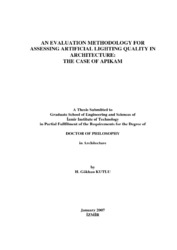Please use this identifier to cite or link to this item:
https://hdl.handle.net/11147/3747| Title: | An Evaluation Methodology for Assessing Artificial Lighting Quality in Architecture: the Case of Apikam | Authors: | Kutlu, Hilmi Gökhan | Advisors: | Günaydın, Hüsnü Murat | Publisher: | Izmir Institute of Technology | Abstract: | The aim of this dissertation is to design a qualitative evaluation methodology for artificial lighting. There is a problem in the general characteristics of lighting industry, deriving from its technical vocabulary which is mainly based on quantitative parameters, values, and systems which in some ways are neglecting the main ingredient of architecture: the user. The evaluation methodology that is subject of this dissertation was considered as a qualitative approach to lighting quality. The study benefited from the knowledge of environmental psychology, concerning the effect of lighting on behaviors and tried to integrate it to the process of assessing lighting quality. The methodology depends on data collection by various means such as surveys, measurements, and computer simulations. To test the qualitative evaluation methodology, a case study was designed in the exhibition hall of the Ahmet Piritina City Archive and Museum (APIKAM) in zmir. The evaluation methodology was successfully operated and made a detailed evaluation possible on the two lighting systems in the exhibition hall of APIKAM. Both lighting systems failed in functional aspects, because of the high intensity of light they produce, the emission of UV and IR wavelengths, and glare problems. They are simply not appropriate for the selected environment, where organic . based materials are exhibited. Recessed fluorescent lighting system failed in physiological aspects as it triggers less arousal than halogen spotlighting system. Both lighting systems have failed in attention scale under psychological aspects, because none of them supply continuity in the order of visual clues that match with the sequential order of the exhibition. For aesthetic and environmental judgments, the results of the survey showed that halogen lighting system was the preferred one by the subjects. For the sub-part of feelings, recessed fluorescent lighting systems failed, because it influenced generally negative feelings, while positive feelings are generally influenced by halogen spotlighting system. | Description: | Thesis (Doctoral)--İzmir Institute of Technology, Architecture, İzmir, 2007 Includes bibliographical references (leaves: 125-134) Text in English;Abstract: Turkish and English xiii, 269 leaves |
URI: | http://hdl.handle.net/11147/3747 |
| Appears in Collections: | Phd Degree / Doktora Sürdürülebilir Yeşil Kampüs Koleksiyonu / Sustainable Green Campus Collection |
Files in This Item:
| File | Description | Size | Format | |
|---|---|---|---|---|
| T000290.pdf | DoctoralThesis | 57.07 MB | Adobe PDF |  View/Open |
CORE Recommender
Page view(s)
296
checked on Mar 31, 2025
Download(s)
174
checked on Mar 31, 2025
Google ScholarTM
Check
Items in GCRIS Repository are protected by copyright, with all rights reserved, unless otherwise indicated.